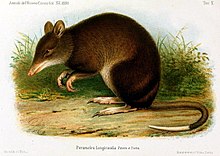| Striped bandicoot[1] | |
|---|---|

| |
| Scientific classification | |
| Domain: | Eukaryota |
| Kingdom: | Animalia |
| Phylum: | Chordata |
| Class: | Mammalia |
| Infraclass: | Marsupialia |
| Order: | Peramelemorphia |
| Family: | Peramelidae |
| Genus: | Microperoryctes |
| Species: | M. longicauda
|
| Binomial name | |
| Microperoryctes longicauda | |

| |
| Striped bandicoot range | |
The striped bandicoot (Microperoryctes longicauda) is a species of marsupial in the family Peramelidae. It is found in West Papua and Papua New Guinea. Its natural habitat is subtropical or tropical dry forests.[2] The striped bandicoot is a host of the Acanthocephalan intestinal parasite Australiformis semoni.[3]
References
[edit]- ^ Groves, C. P. (2005). Wilson, D. E.; Reeder, D. M. (eds.). Mammal Species of the World: A Taxonomic and Geographic Reference (3rd ed.). Baltimore: Johns Hopkins University Press. p. 42. ISBN 0-801-88221-4. OCLC 62265494.
- ^ a b Leary, T.; Wright, D.; Hamilton, S.; Singadan, R.; Menzies, J.; Bonaccorso, F.J.; Helgen, K.; Seri, L.; Aplin, K.; Dickman, C.; Salas, L. (2016). "Microperoryctes longicauda". IUCN Red List of Threatened Species. 2016: e.T84783217A21965649. doi:10.2305/IUCN.UK.2016-3.RLTS.T84783217A21965649.en. Retrieved 12 November 2021.
- ^ Schmidt, Gerald D.; Edmonds, Stanley J. (1989). "Australiformis semoni (Linstow, 1898) n. Gen., n. Comb. (Acanthocephala: Moniliformidae) from Marsupials of Australia and New Guinea". The Journal of Parasitology. 75 (2): 215–7. doi:10.2307/3282769. JSTOR 3282769. PMID 2926590.

Well, that’s interesting to know that Psilotum nudum are known as whisk ferns. Psilotum nudum is the commoner species of the two. While the P. flaccidum is a rare species and is found in the tropical islands. Both the species are usually epiphytic in habit and grow upon tree ferns. These species may also be terrestrial and grow in humus or in the crevices of the rocks.
View the detailed Guide of Psilotum nudum: Detailed Study Of Psilotum Nudum (Whisk Fern), Classification, Anatomy, Reproduction